Climate change is undeniable (don’t argue), unequivocal and impacting underwater ecosystems.
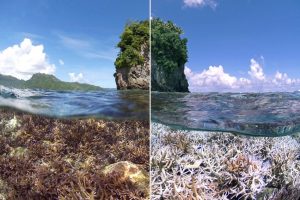
Expanding from ‘Finding Nemo’, coral reefs are diverse underwater ecosystems playing host to symbiotic algae called Symbiodinium (Baker, Glynn and Riegl, 2008). This symbiotic relationship is mutually beneficial; algae capture sunlight and perform photosynthesis providing oxygen and nutrients to coral, whilst coral provides algae with a protected environment and photosynthetic compounds. However, this relationship is vulnerable to climate change, existing exclusively within narrow temperature limits associated with shallow, sunlit waters (Frieler et al., 2012). When exposed to above-normal temperatures, stressed corals expel dinoflagellates (Symbiodinium) from its tissues exposing its bleach-white skeleton (‘witwoo’) in a process called Coral Bleaching(figure1&2).
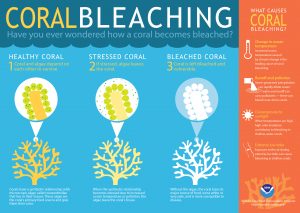
The IPCC (2007) reported with HIGH confidence that observed changes in marine systems are associated with rising ocean temperatures. This is obviously not linked to the average 0.8℃ global ‘human-induced‘ temperature rise between 1961-2010 (NOAA, 2016) (figure 3); yes I’m rolling my eyes. Average tropical sea surface temperature (SST) has risen by 0.7℃ since 1970 (NOAA, 2016; figure3), parallel to atmospheric temperatures and with considerable variability, from our friend El Nino (NOAA, 2016). This is ultimately driving Coral Bleaching.
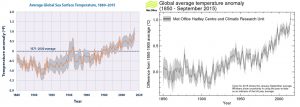
Still not convinced?
Bleaching has been SCIENTIFICALLY-PROVEN to correlate with climate-induced temperature rise, notably after 1970. For example, a 35% increase in Caribbean bleaching incidence between 1980-1990 resulted from a 1℃ regional SST rise (Baker, Glynn & Riegl, 2008). Case-studies are summarised in figure4ab.
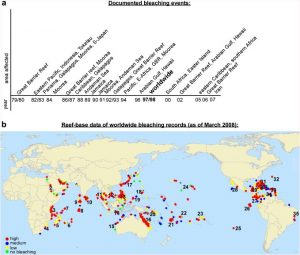
Source: Baker, Glynn & Riegl, 2008.
The third global bleach was designated by the NOAA in 2016; the first (1998) decimated 16-19% of the world’s coral (NOAA, 2017). A strong el-Nino (2016-2017) worsened the bleach and as of February 2017, the on-going global bleach continues to be the longest and most prevalent on record (NOAA, 2017; figure5).
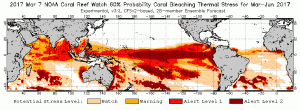
The ecological impacts of coral bleaching and related mortality you say? I’ve chosen my favourites.
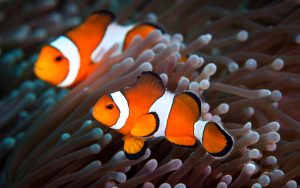
Coral reefs are underwater rainforests. Covering 1% of the ocean floor, they support a 1/4 of all ocean life by providing the foundations for complex food webs and essential nurseries, spawning, breeding and feeding habitats (Jones et al., 2004; Bellard et al., 2012). An 8-year study in Papua New Guinea saw a dramatic decline in coral cover and a parallel decline in fish biodiversity; 75% of reef species declined in abundance (Jones et al., 2004). Yes folks, this includes much loved ‘Nemo’, the Pomacanthidae family(figure 6).
Coral diseases (figure 7) have been observed to correlate with temperature anomalies and bleaching events (Weil, 2004). Bleaching in the US Virgin Islands (a piece of the Caribbean ‘disease-hotspot’), followed by a disease outbreak (2005), resulted in severe reef degradation; the amount of living coral cover decreased by 60% (Jackson et al., 2014). Reported impacts included a reduction in live coral cover and considerable changes in community structure, diversity and abundance of reef-associated organisms (Weil, 2004).
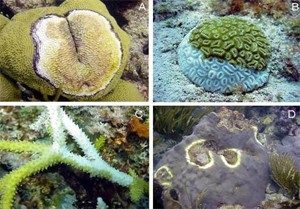
Bad news, the Worlds Resource Institute reports 10% of coral reefs are permanently damaged; even worse, global warming trends suggest SST will reach that pesky 1℃ resulting in increased bleaching frequency and intensity (Burke et al., 2011). If we continue business-as-usual, 90% of coral reefs will be in danger by 2030 and all by 2050 (Burke et al., 2011).
References
Baker, A.C., Glynn,P.W. & Riegl,B., 2008. Climate change and coral reef bleaching: An ecological assessment of long-term impacts, recovery trends and future outlook. Estuarine, Coastal and Shelf Science, 80(4), pp. 435-471.
Bellard, C., Bertelmeier, C., Leadley, P., Thuiller, W. & Courchamp, F., 2012. Impacts of climate change on the future of biodiversity. Ecology Letters, 15(4), pp. 365-377.
Burke, L., Reytar, K., Spalding, M. & Perry, A., 2011. Reefs at Risk Revisited , s.l.: Worlds Resource Institute .
Frieler, K., Meinshausen, M., Golly, A., Mengel, M., Lebek, K., Donner, S. & Hoegh-Guldberg, O., 2013. Limiting global warming to 2 ◦C is unlikely to save. Nature Climate Change, Volume 3, pp. 165-170.
IPCC, 2007. Climate Change 2007: Synthesis Report, Valencia: IPCC.
Jackson, J., Donovon, M., Cramer, K. & Lam, V., 2014. Status and Trends of Caribean Coral Reefs: 1970-2012, Washington, D.C. : Global Coral Reef Monitoring Network.
Jones, G. P., McCormick, M. I., Srinivasan, M. & Eagle, J. V., 2004. Coral decline threatens fish biodiversity in marine reserves. PNAS, 101(21), pp. 8251-8253.
National Oceanic and Atmospheric Administration (NOAA), 2016. Global Analysis- Annual 2016. [Online]
Available at: https://www.ncdc.noaa.gov/sotc/global/201613
National Oceanic and Atmospheric Administration (NOAA), 2017. Coral Reef Watch. [Online]
Available at: https://coralreefwatch.noaa.gov/satellite/analyses_guidance/global_coral_bleaching_2014-17_status.php
[Accessed 20 03 2017].
Weil, E., 2004. Coral reef diseases in the wider Caribbean. In Coral health and disease (pp. 35-68). Springer Berlin Heidelberg.
[Word Count excluding title, captions and references: 500]
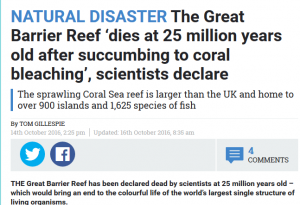
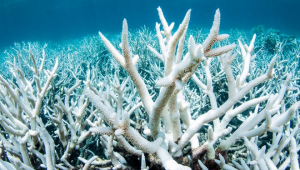
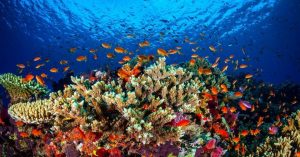

Recent Comments